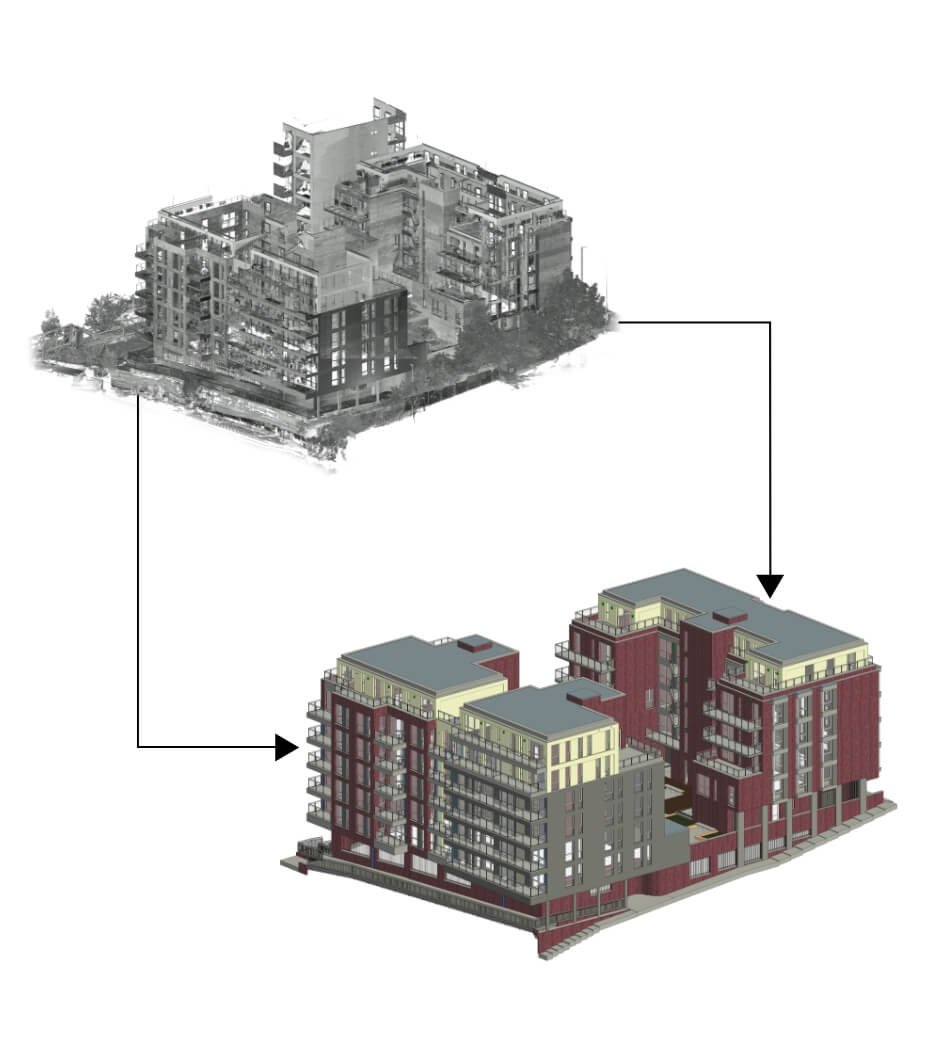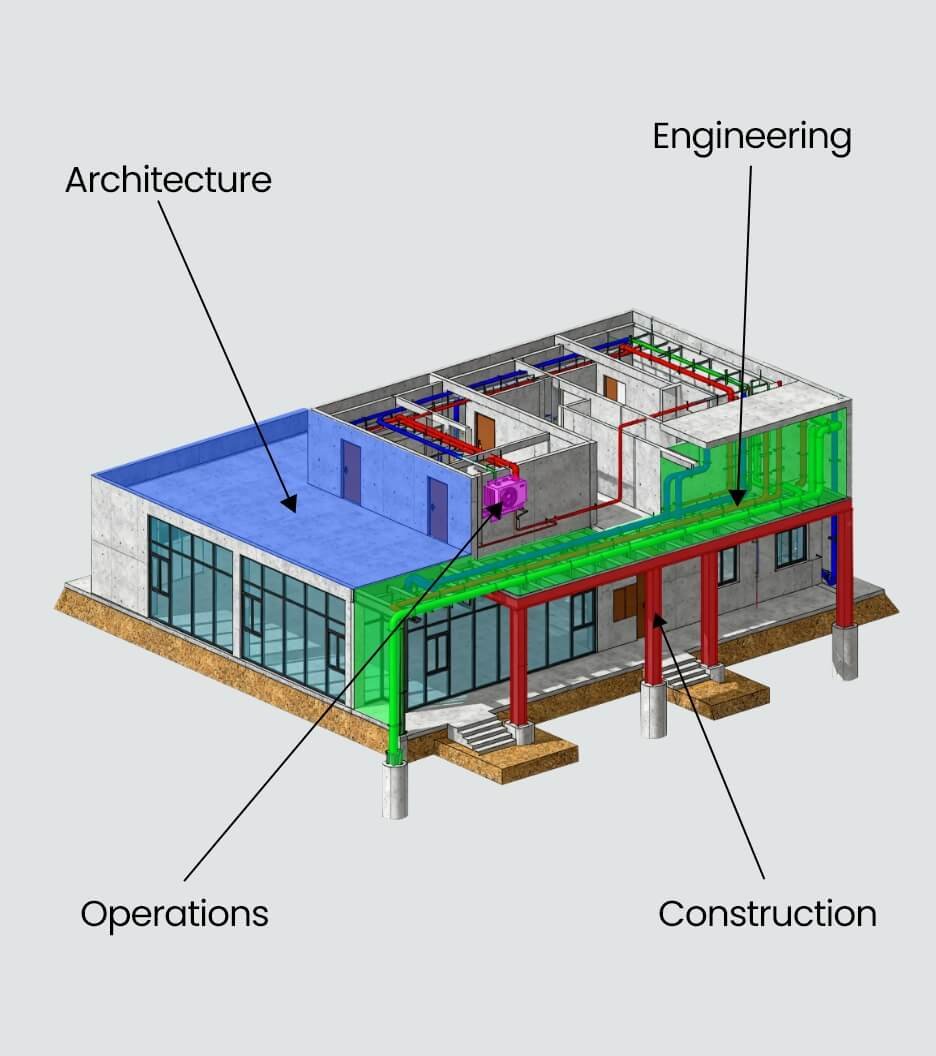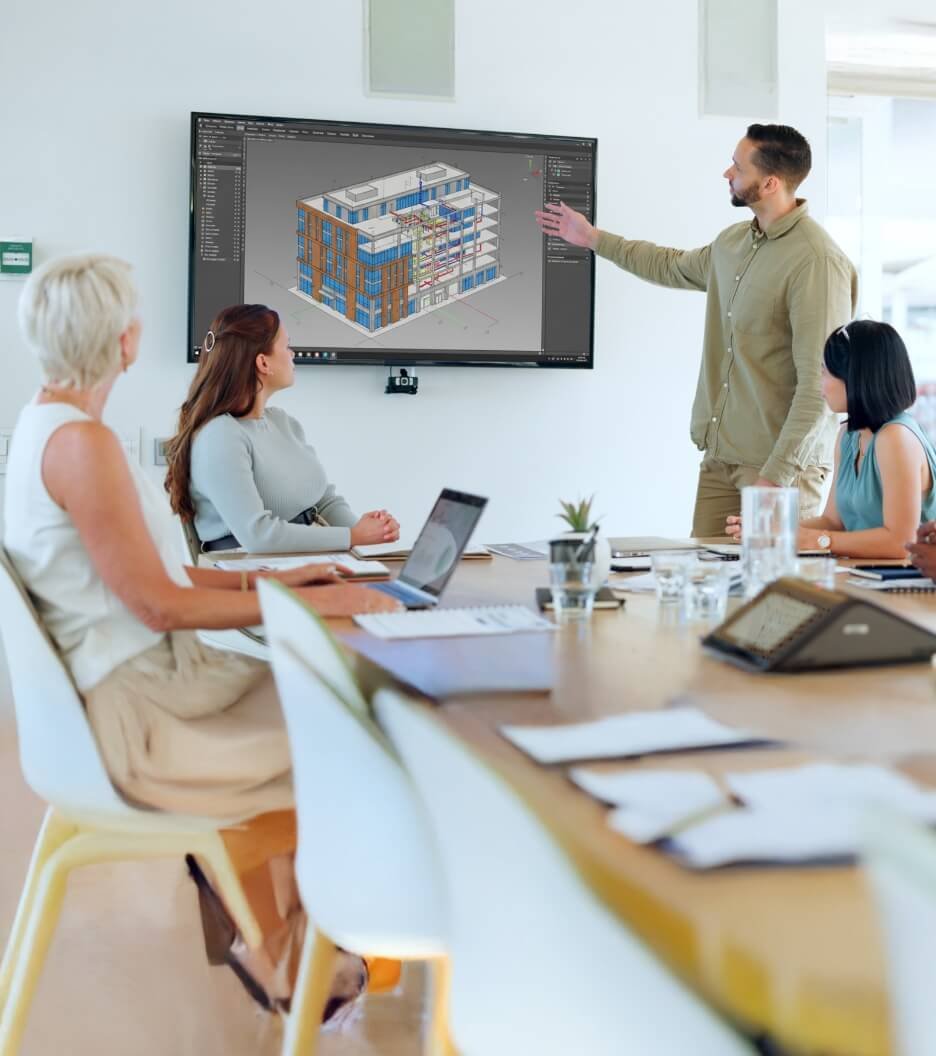 Parth Patel
Parth Patel
Scan to BIM in Infrastructure Projects: Roads, Bridges and Tunnels
 Parth Patel
Parth Patel

Send Us Your Requirement
Accuracy, efficiency, and safety are three pillars of a successful construction project. In the modern world, the construction and architecture industry is continuously transforming with the evolution of technology. Innovation and technology play a significant role in offering accurate, efficient, and safe solutions in the AEC sector. Architects, engineers, designers, and other professionals look for significant ways to enhance the construction process, streamline operations, and ensure building safety. Today, modern architecture and construction are reshaped by pivotal technology known as BIM services, which have brought enhanced, accurate, and more efficient construction results from start to finish.
Building information modeling introductions has altered how architects, designers, engineers, and other professionals work together. Due to the complex and lengthy construction process, BIM offers a holistic approach with several benefits, making it easier to navigate the intricate process. AEC is a vast sector comprising a variety of constructions, ranging from small to large scale, from residential to commercial, and including infrastructure development and more.
Regardless of construction type, accuracy and efficiency are prominent for a project’s success. Speaking of which, infrastructure development projects are far more critical and complicated, requiring keen precision. Roads, highways, bridges, tunnels, and other infrastructure projects fall under complex projects that are often too intricate in nature. Considering the use, purpose, and idea of such development directly impacts the country’s growth. Better development and more growth are the reasons why 3D BIM modeling services play a crucial role in infrastructure development projects. BIM focuses on managing complex design and on-site work, ensuring accuracy and safety for long-term use.
The safety and longevity of roads, bridges, tunnels, and more are essential for public well-being and also facilitate stronger national development. Since the development of these bridges, roads, or tunnels is a one-time investment, it is evident that maintaining this infrastructure is crucial to avoid any risks or mishappenings. Hence, to sustain efficiency and longevity in the infrastructure project, point cloud modeling services are beneficial. Since traditional methods or manual surveys of infrastructure projects are time-consuming, prone to errors, and less efficient, scanning for BIM becomes a profitable approach for early detection of structural weaknesses or areas of risk. Let’s explore in detail about scan to BIM for infrastructure.
Manage Large Scale Infrastructure Project with Scan to BIM Modeling
Get a Quote
What is Point Cloud to BIM Service?
In the complex sector of architecture and construction, Scan to BIM services stand out as they allow AEC professionals to intricately work on existing structures. After constructing the building, it is vital to maintain the facility, keep it functioning, and ensure the safety standard. Here, laser scanning technology plays a vital aspect that is further integrated into the 3D BIM model. With advanced technology, AEC professionals can easily manage existing infrastructure, refine facility management, and ensure safety.
Scan to 3D BIM modeling services have become popular in the architecture and construction industry due to a variety of aspects and benefits from it. The primary goal is to capture, interpret, and translate the data into a BIM model, allowing professionals to identify areas of fault or potential renovations. Following are some of the key benefits of point cloud modeling services.
Perks of Scan to BIM in AEC
Enhanced accuracy
Cost savings
Seamless workflow
Improved collaboration
Clash detection and conflict resolution
- Enhanced accuracy: With the help of laser scanning technology, Scan to BIM ensures improved accuracy and efficiency in complex design structures, as it collects data points from inaccessible areas and provides insights for repairs. This helps to escalate the project and maintain accuracy during the project.
- Seamless workflow: Integrated with the 3D BIM model, AEC professionals can identify issues, conflicts, and more in the existing structure and make the required changes. The BIM workflow fosters a faster and streamlined process, as every AEC expert works on the same model, resulting in enhanced accuracy.
- Cost savings: Another significant benefit of point clouds in BIM is the cost efficiency during the project. Managing, repairing, or renovating an existing infrastructure requires resources, materials, technology, and more. With point cloud to BIM, professionals allocate and manage resources according to the digital information.
- Improved collaboration: Point cloud to BIM services enhances collaboration by providing a shared space for architects, engineers, and other collaborators to fulfill their respective roles. This enhances collaboration, reduces errors, and streamlines work approaches for complex infrastructure design.
- Clash detection and conflict resolution: Scan to BIM facilitates early clash detection and brings definitive solutions by proposing required changes in the existing structure plane. Clash detection reduces rework, minimizes delays, and enhances project efficiency.
These are a few benefits of point cloud modeling services. As the list can be extensive, this laser scanning technology is also crucial for infrastructure projects, including roads, bridges, and tunnels. Point cloud to BIM for roads and other mega projects helps to identify key areas of structural weakness, ensuring public well-being and avoiding any mishaps. Explore in detail how scanning to BIM is helpful for infrastructure projects.
Scan to BIM for Infrastructure Project: A Crucial Role
Infrastructure construction and maintenance are tough and critical tasks. The world’s infrastructure is the backbone of the economy, as it is said, “better infrastructure, advanced economy.” As we look around, buildings’ designs have become more intricate, marvelous, and unique. But ever thought about how roads, bridges, tunnels are constructed?
Today, in the fast-paced world, roads are interconnected, widened, and smooth. Bridges seamlessly improve traffic flow, enhance better connectivity for travel, and more. To ensure these infrastructures are safe for public use, it is essential to adhere to regulatory standards. Here Point cloud to BIM software is a game changer. The detailed model, through the laser scanning process, supports structural analysis, compliance with regulatory standards, identifying crucial flaws, streamlining projects, and more.
As important as the service is, point cloud to BIM offers accurate as-built documentation and enables proper asset management. Typically, the process involves 3D laser scanning of the structure and integrating the collected point data into a 3D BIM model. As a matter of fact, bridge BIM modeling, tunnel, and road offer accurate digital representation that enables AEC professionals to minimize errors and enhance accuracy along with safety during the process. Explore various applications of the scan-to-BIM services for different infrastructure projects.
- Roads: Capturing existing road conditions, including surface irregularities, pavement distress, and signage, to plan for maintenance, overlays, or widening projects, scan-to-BIM services bring enhanced solutions and maintain efficiency. Moreover, the model is also used to predict future road intersections and interchanges, significantly reducing potential conflicts. This promotes traffic flow, enhances safety, and improves time management for travel. Scan-to-BIM models are also used for utility mapping, which enables the identification of existing underground utilities, such as cables, pipes, and more. It helps to reduce clashes during the process. Not only this but point cloud to BIM for roads can also be integrated with GIS (Geographic Information Systems) for infrastructure management.
- Bridges: Scan to BIM monitors structural health, involving the detection of minor deformations, cracks, potential collisions, areas for improvement, and necessary repairs. This helps to safeguard public well-being as well as means of communication for travel. As a matter of fact, bridge BIM modeling helps to maintain and enhance the lifespan of the bridge. Additionally, with a built model, experts can implement repair plans or structural enhancement without compromising the position of existing components. Since bridges are mega-infrastructure projects that demand utmost safety, verifying cleaners for new projects is evident when compiling safety regulations. Scan to BIM also helps in restoring and documenting intricate historical bridge details while maintaining accuracy and precision.
- Tunnels: Constructing and maintaining tunnels is a tedious and critical job. Here, Tunnel BIM modeling brings efficient solutions for the identified defects, cracks, and water entrance, which is vital for maintaining safety and precision. The Scan to BIM model is also optimally utilized for structural analysis and monitoring tunnel stability to identify areas for improvement. Here, the role of MEP BIM services also comes into play, considering proper lighting, ventilation, and water management in the confined space of the tunnel. 3D BIM modeling services provide a digital representation of physical and functional characteristics, while point cloud services ensure the safety and stability of tunnels. As a matter of fact, constructing a tunnel also means having utilities mapping for geographic information to avoid any risks, errors, or challenges during the significant process.
This is how roads, bridges, and tunnels are maintained, repaired, and constructed. Point cloud to BIM services provide holistic solutions for infrastructure projects, as precision, attention to detail, and efficiency are key to success. As a matter of fact, scan to BIM for infrastructure also brings several benefits, including;
Key Benefits of Scan to BIM for Infrastructure Projects
Lifecycle management
Improved communication and collaboration
Minimize errors and reworks
Early clash detection
Enhanced efficiency and precision
Cost-effective
These benefits highlight the crucial importance of scan-to-BIM technology and how mega-scale infrastructures are designed and maintained. The AEC industry leverages the power of the latest technology and innovation to consistently deliver improved results. This fosters the integration of new trends, technologies, and innovations that yield better results. Explore the future horizon of point cloud modeling services.
Future Outlook of Scan to BIM
The architecture and construction realm has come a long way, witnessing a transformation wave in methodologies and approaches. As traditional work methods have become increasingly ineffective in the face of the growing impact of modern solutions, technologies, and emerging innovations, the AEC industry is now revolutionized with upscaling performance. Accuracy, efficiency, and precision in the architecture project are vital, and BIM services were the significant role players. As evolution is continuous and advancements continue to reshape the industry, the architecture and construction industry has witnessed new technologies for greater precision and ease in the process.
Scan to BIM is a popular approach for renovation, infrastructure, and other projects, but the future of this approach looks promising with an advanced method that leads to greater efficiency, accuracy, and seamless integration with other tools. Following are some of the emerging trends and technologies that can further revolutionize the approach.
- Digital twins
- Better scanning devices
- Cloud-based collaboration
- AI and ML
- AR and VR
These emerging technologies transform point cloud data into 3D BIM modeling services. As it is not just a technology but a holistic asset for the AEC industry, the integration of the innovation mentioned above will bring enhanced results, well-managed facilities, and proactive solutions to challenges. Due to its growing significance, promising future outlook, and numerous benefits, it is advisable to outsource scanning to BIM for infrastructure projects. Considering the scale and complexity of projects, outsourcing experts can offer reliable solutions, allowing AEC firms to focus on their core responsibilities. Understand in detail why outsourcing point cloud to BIM solutions are valid.
Insights to Outsourcing Point Cloud to BIM Solutions
AEC firms are always seeking effective ways to enhance current processes and streamline operations. With mega-scale infrastructure projects in hand, such as roads, bridges, tunnels, or dams, it is crucial to focus on the core task. From strategic planning to smooth execution, many challenges and hindrances arise, which is why AEC firms outsource scan to BIM services from a reliable service provider to have hands on the most precise model while streamlining the daily operations.
Additionally, instead of hiring an in-house team, outsourcing BIM experts is a more beneficial and cost-effective approach for AEC firms. As scan to BIM is a critical role player in the AEC projects, strategic planning and approach are equally important. Outsourcing services providers have a team of professionals and significant technologies that ensure precision in the project while strictly adhering to regulations. Following are some of the major benefits of outsourcing point cloud BIM services;
- Cost-effective
- Strategic approach
- Access to the latest technology and experts
- Timely project delivery
- Accurate and efficient outcomes
- Tailored solutions
These benefits highlight the importance of outsourcing scan to BIM services to professionals. It demands keen attention to detail, the use of accurate software tools, and a strategic approach to implementation. UniquesCADD is a top scan to BIM company with significant experience and a team of professionals. With the use of the latest tools, we ensure that we offer the most precise and accurate results for our architecture projects.
Concluding Remarks
Point cloud modeling services are crucial in the AEC realm, offering accurate and efficient results for renovation projects or mega infrastructure projects to ensure precision, safety, and facility management.


